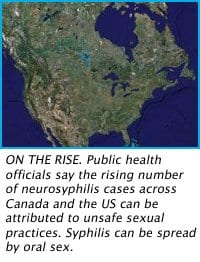There has recently been a sharp increase of reported local cases of neurosyphilis, a syphilis infection of the brain and spinal cord that most commonly affects HIV-positive people. There has been an increase in Toronto, Ottawa and Vancouver, primarily among men who have sex with men (MSM).
“It can lead to death… but it is preventable,” says Toronto Public Health official Vinita Dubey, adding that most of Toronto’s cases of neurosyphilis have been in men.
If left untreated neurosyphilis can lead to severe headaches and mental confusion, blurred vision and partial facial paralysis, loss of sense of smell and basic motor skills, as well as acute meningitis and even stroke. Many symptoms can continue to linger months after treatment.
Dubey says Toronto experienced its first jump in neurosyphilis rates in 2002, when the city went from averaging from zero to two cases a year to 11 reported cases. Since then the numbers have ranged to a high of 16 cases in 2004, to a low of seven reported infections last year.
The numbers are even higher in Ottawa. Paul MacPherson, a professor at the University of Ottawa and infectious disease specialist at Ottawa Hospital, says that from June 2001 to June 2006 the nation’s capital reported 102 neurosyphilis cases, an average of about 20 cases a year during that five-year period.
“That’s a 10-fold increase over what we used to see,” MacPherson says, adding that the majority of Ottawa’s reported cases are among HIV-positive MSM.
Although Mark Gilbert of British Columbia’s Centre for Disease Control says the centre does not yet have solid numbers, Vancouver has also seen an increase in the number of anecdotal neurosyphilis reports since 2005.
“There is an increased awareness… but we don’t have good data yet,” Gilbert says, adding that Vancouver has experienced an overall resurgence in syphilis infections since 2003 — the second outbreak over the last 10 years in the city — among gay and bisexual men.
The Canadian numbers mirror those found in several large US cities, including New York, Chicago and Los Angeles, according to a US Centers for Disease Control (CDC) report released in late June. In it CDC officials report a sharp increase in neurosyphilis rates among HIV-positive MSM between 2002 and 2004.
Gilbert says it is unclear why syphilis rates among gay and bisexual men throughout Canada and the US are on the rise, but it could be the result of a general relaxation in safer-sex practices and serosorting (the practice of having sex with those of the same HIV status), as well as a greater awareness of the need for at-risk individuals to get tested for STIs.
“Why is there this outbreak?… that’s the million-dollar-question,” says Gilbert. While public health officials agree that no single factor can be blamed for the outbreak, they are concerned that MSM aren’t taking precautions against sexually transmitted infections other than HIV.
“The adoption of [safer-sex] practices to decrease HIV infection do not necessarily lower risks for other STIs,” Gilbert says.
MacPherson agrees. “Syphilis is easily spread by oral sex. Syphilis is passed on through contact, not semen.”
“Safe-sex messages are not being heard,” Dubey says, adding that cases of chlamydia and gonorrhea are also on the rise in Toronto and elsewhere. “It’s not just syphilis.”

 Why you can trust Xtra
Why you can trust Xtra


